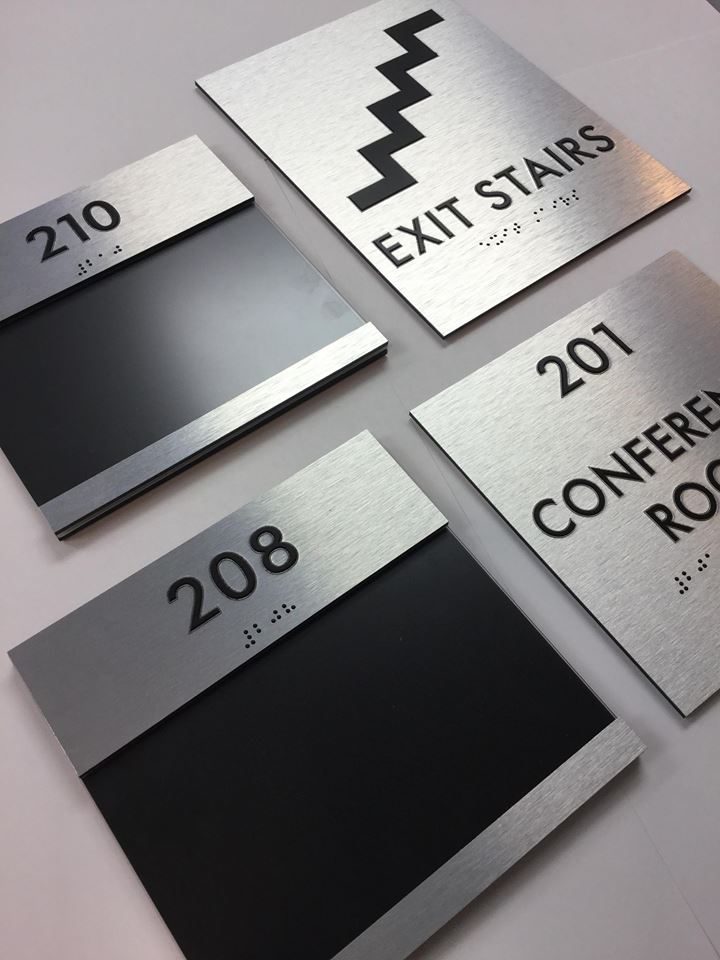How ADA Signs Boost Availability for Everyone
Wiki Article
Exploring the Trick Features of ADA Indicators for Enhanced Ease Of Access
In the world of ease of access, ADA indicators serve as quiet yet effective allies, guaranteeing that rooms are inclusive and accessible for people with specials needs. By integrating Braille and responsive elements, these indications damage barriers for the aesthetically damaged, while high-contrast color systems and readable typefaces provide to varied visual requirements.Significance of ADA Compliance
Guaranteeing compliance with the Americans with Disabilities Act (ADA) is crucial for promoting inclusivity and equal access in public rooms and workplaces. The ADA, passed in 1990, mandates that all public centers, companies, and transportation services fit people with disabilities, ensuring they take pleasure in the very same rights and opportunities as others. Compliance with ADA requirements not just fulfills legal responsibilities but also improves a company's credibility by demonstrating its commitment to diversity and inclusivity.One of the key elements of ADA conformity is the execution of easily accessible signs. ADA signs are created to make certain that individuals with handicaps can easily navigate with rooms and structures.
Moreover, adhering to ADA guidelines can mitigate the risk of potential penalties and lawful repercussions. Organizations that stop working to abide by ADA guidelines may face lawsuits or fines, which can be both monetarily challenging and harmful to their public image. Thus, ADA conformity is essential to cultivating an equitable setting for everyone.
Braille and Tactile Components
The consolidation of Braille and responsive elements right into ADA signage symbolizes the concepts of availability and inclusivity. These features are vital for individuals that are aesthetically damaged or blind, enabling them to browse public rooms with greater independence and self-confidence. Braille, a responsive writing system, is necessary in providing written information in a style that can be easily viewed via touch. It is generally placed below the matching message on signs to ensure that individuals can access the information without visual help.Tactile aspects prolong past Braille and include increased personalities and signs. These parts are created to be discernible by touch, permitting people to recognize room numbers, washrooms, exits, and various other crucial locations. The ADA sets specific guidelines relating to the dimension, spacing, and placement of these responsive components to enhance readability and make certain uniformity throughout different settings.

High-Contrast Color Design
High-contrast shade schemes play a pivotal function in boosting the visibility and readability of ADA signs for individuals with aesthetic impairments. These systems are essential as they optimize the distinction in light reflectance in between text and background, guaranteeing that signs are quickly discernible, even from a range. The Americans with Disabilities Act (ADA) mandates the use of particular shade contrasts to fit those with limited vision, making it a crucial element of conformity.The efficacy of high-contrast colors hinges on their capability to stand out in different lighting conditions, including poorly lit atmospheres and locations with glow. Usually, dark message on a light background or light text on a dark history is employed to accomplish ideal contrast. Black text on a white or yellow history gives a raw aesthetic distinction that assists in quick recognition and understanding.

Legible Fonts and Text Size
When considering the design of ADA signage, the selection of readable fonts and suitable text dimension can not be overemphasized. The Americans with Disabilities Act (ADA) mandates that typefaces should be not italic and sans-serif, oblique, manuscript, very ornamental, or of unusual form.According to ADA guidelines, the minimal text height need to be 5/8 inch, and it must enhance proportionally with viewing range. Uniformity in message size contributes to a natural visual experience, assisting people in browsing atmospheres successfully.
Moreover, spacing between lines and letters is essential to clarity. Adequate spacing stops characters from showing up crowded, boosting readability. By adhering to these standards, designers can considerably boost availability, making sure that signage serves its intended purpose for all individuals, despite their visual abilities.
Reliable Placement Methods
Strategic positioning of ADA signage is essential for maximizing ease of access and making certain compliance with legal requirements. Effectively positioned indications lead individuals with impairments successfully, promoting navigation in public areas. Trick factors to consider include presence, closeness, and elevation. ADA guidelines stipulate that signs ought to be installed at an elevation in between 48 to 60 inches from the ground to guarantee they are within the line of view for both standing and seated people. This typical height range is crucial for inclusivity, allowing mobility device customers and people of differing elevations to access information effortlessly.Furthermore, indications should be put beside the lock side of doors to enable easy recognition prior to entry. This positioning assists individuals situate rooms and areas without obstruction. In instances where there is no door, signs should be located on the closest surrounding wall. Consistency in indicator placement throughout a facility boosts predictability, minimizing confusion and boosting general user experience.

Conclusion
ADA indicators play a vital function in promoting access by integrating attributes that address the demands of people with disabilities. Integrating Braille and responsive components guarantees crucial details comes to the aesthetically impaired, Discover More Here while high-contrast Recommended Site shade plans and legible sans-serif typefaces improve visibility throughout different lighting problems. Efficient placement techniques, such as ideal placing heights and calculated places, even more facilitate navigating. These elements collectively cultivate a comprehensive environment, highlighting the significance of ADA conformity in ensuring equivalent accessibility for all.In the realm of accessibility, ADA signs serve as quiet yet powerful allies, guaranteeing that spaces are navigable and comprehensive for individuals with impairments. The ADA, enacted in 1990, mandates that all public facilities, employers, and transport services suit people with handicaps, guaranteeing they appreciate the very same rights and opportunities as others. ADA Signs. ADA signs are created to make sure that people with disabilities can easily browse via rooms and structures. ADA guidelines state that indicators must be mounted at a height in between 48 to 60 inches from the ground to guarantee they are within the line of sight for both standing and seated people.ADA indications play a vital duty in promoting ease of access by integrating features that deal with the demands of individuals with specials needs
Report this wiki page